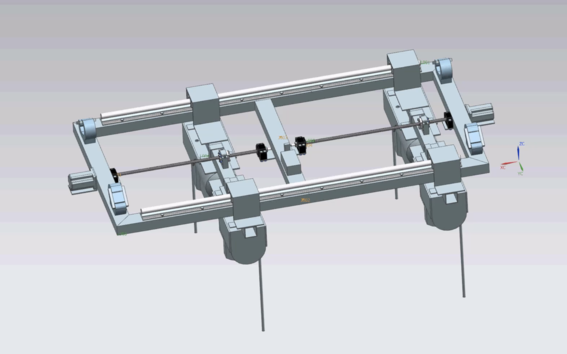Mechatronics students claim top three prizes in development project competition

The end results of this spring's Mechatronics Project course had an opportunity to shine in a development project competition hosted by industrial production and maintenance association Promaint and the Finnish Fair Foundation. The competition sought the best of small-scale projects conducted during spring 2020 in collaboration between a company and a team of students. The overall winner of the competition was a team from Aalto University, while two other Aalto University teams shared second place.
The top prize went to Aleksi Kuuva, Sean Connor, Paavo Palomäki and Mikko Heliö for their project, a remotely controlled device that can be used to rotate an object being lifted by the hook of a crane. The team's industrial partner was Konecranes.
'The Mechatronics Project course is great because it lets you run a project from start to finish and build something you've designed yourself. It's also good to work on a project with a company, since solving real-life problems always makes things more interesting. We couldn't go to the campus during the spring, but we were able to bring materials home and do some partial testing remotely,' said Aleksi, Mikko, Paavo and Sean.
The competition's panel of judges considered the solution to be innovative and applicable to many cases. From the perspective of maintenance, it can increase effectiveness when replacing or installing devices in cramped locations. The solution also increases safety while lifting thanks to included centre-of-gravity control and rotation functionality. The judges also highlighted the user-friendliness of the device, especially the fact that it can be controlled remotely.
Konecranes gave the winning team not only a lot of freedom, but support as well. The students received rapid answers to their questions and encouragement to be creative. Sean, who was learning Finnish during the project, had opportunities to practice the language both in the technological discussions and in less formal settings. The Finns were glad to help out, and Sean found the experience invaluable.
Find out more about the winning device here.
Motivating students and companies to collaborate
'The aim of the competition was to support collaboration between companies and educational institutions. Aalto University is an excellent partner in collaborative projects like these and we understand they have a reputation for it,' said Executive Director Jaakko Tennilä of Promaint ry.
Students Kimmo Hirvonen, Mehrdad Khodayari, Robert Hermansson and Muhammad Usman formed a team that shared second place in the contest. Working with Siemens, the team designed and built a research setting around a linear motor for studying the thermal behaviour of the motor's carrier through simulation and testing. Linear motors are used in industrial applications that call for fast and accurate motion, for example when shaping sheet metal or in an assembly system. The research topic is an important one, as a linear motor's speed, accuracy and load capacity degrade as the electromagnets in the carrier heat up. This heat can be managed with liquid cooling, but often these applications are designed to avoid using cooling systems, which is why knowledge of a motor's thermal behaviour is valuable.
A team composed of students Fernando Marquina Magañan, Antti Honkanen and Diwakar Gupta was also given second-place honours for their device, which cuts and bends coaxial wires in a cryostat. Cryostats are used to freeze quantum computers close to absolute zero. As coaxial wires are connected to a quantum computer processor inside a cryostat, they are subject to extreme temperature variations and special attention must be paid to their bending. The device created by the team automates the bending and cutting process, helping to create wires of uniform quality and to facilitate larger production runs. The team's partner in the project was Bluefors.
The winning team received a prize of 4 000 euros, while the two runners-up received 1 000 euros each.
The final works from the Mechatronics Project course are usually presented to the public at the annual Mechatronic Circus event gathering almost 500 visitor yearly. This year the event had to be held online with only students and their teachers Professor Petri Kuosmanen and Senior University Lecturer Panu Kiviluoma participating. Find out more about all the final works of the Mechatronics Project course on the Mechatronic Circus 2020 event page.
Read more news

Get to know us: Associate Professor Maria Sammalkorpi
Sammalkorpi received her doctorate from Helsinki University of Technology 2004. After her defence, she has worked as a researcher at the Universities of Princeton, Yale and Aalto.
Aalto computer scientists in ICML 2024
Computer scientists in ICML 2024
Getting bacteria into line
Physicists use magnetic fields to manipulate bacterial behaviour